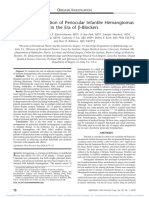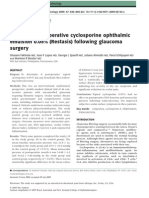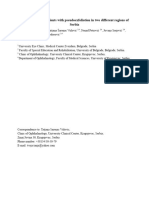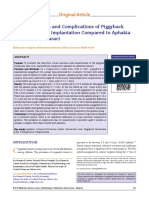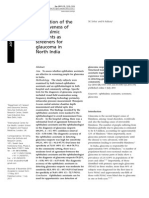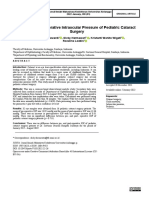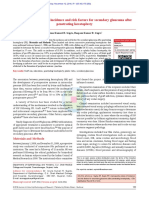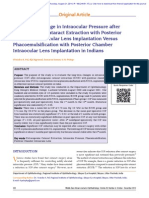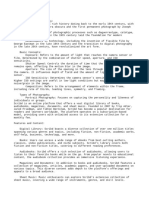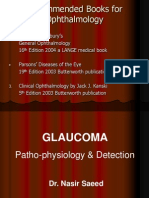Glaucoma After Congenital Cataract Surgery
Glaucoma After Congenital Cataract Surgery
Uploaded by
Samawi RamudCopyright:
Available Formats
Glaucoma After Congenital Cataract Surgery
Glaucoma After Congenital Cataract Surgery
Uploaded by
Samawi RamudOriginal Title
Copyright
Available Formats
Share this document
Did you find this document useful?
Is this content inappropriate?
Copyright:
Available Formats
Glaucoma After Congenital Cataract Surgery
Glaucoma After Congenital Cataract Surgery
Uploaded by
Samawi RamudCopyright:
Available Formats
Glaucoma after Congenital Cataract Surgery
Mahmoodreza Panahi Bazaz, MD1 Farideh Sharifipour, MD2 Mitra Zamani, MD2
Ali Sadeghi, MD3 Hossein Roostai, MD3 Seyed Mahmood Latifi, MSc4
Abstract
Purpose: To determine the incidence and risk factors associated with glaucoma following
congenital cataract surgery (CCS) in children under age of 15
Methods: This prospective cohort (since 2006) consisted of children less than 15 years of age who
underwent cataract surgery with or without intraocular lens (IOL) implantation. The role of the
following factors on the development of glaucoma after CCS including age at surgery, gender,
laterality of the cataract, IOL implantation, congenital ocular anomalies, intra- and postoperative
complications, length of follow-up, central corneal thickness (CCT) as well as the effect of the age
of onset, time to development of glaucoma, and response to treatment were evaluated.
Results: Overall, 161 eyes of 96 patients were included in this study of which 28 eyes developed
glaucoma. Incidence of glaucoma was 17.4%. MeanSD age at surgery was 9.36.9 (range, 1-24)
months in glaucomatous and 40.441.1 (range, 1 m-13.6 year) months in non-glaucomatous group
(p<0.001). All glaucoma patients had the operation under two years of age. In group 1, 9 (60%)
and in group 2, 24 (30%) patients were female (p=0.001). In group 1, 17 eyes (60.7%) and in the
group 2, 41 eyes (30.8%) were aphakic (p=0.001). Mean time to diagnosis of glaucoma was 111.2
days (range 30-1200 days). Mean follow-up time was 3.1 years (range, 1-6 years). In 22 (78.6%)
eyes glaucoma was diagnosed within six months after surgery. Glaucoma was controlled with
medications in 23 eyes (82%) and with surgery in five eyes.
Conclusion: In this study the incidence of glaucoma after CCS was 17.4% over a follow-up period
of six years. Younger age at the time of lensectomy increases the risk of secondary glaucoma. IOL
implantation may protect against glaucoma. Female gender was affected more than male.
Keywords: Secondary Glaucoma, Congenital Cataract, Cataract Surgery
Iranian Journal of Ophthalmology 2014;26(1):11-16 2014 by the Iranian Society of Ophthalmology
1. Assistant Professor of Ophthalmology, Department of Ophthalmology, Imam Khomeini Hospital, Ahvaz Jundishapur University of
Medical Sciences, Ahvaz, Iran
2. Associate Professor of Ophthalmology, Department of Ophthalmology, Imam Khomeini Hospital, Ahvaz Jundishapur University of
Medical Sciences, Ahvaz, Iran
3. Department of Ophthalmology, Imam Khomeini Hospital, Ahvaz Jundishapur University of Medical Sciences, Ahvaz, Iran
4. Department of Biostatistics, Ahvaz Jundishapur University of Medical Sciences, Ahvaz, Iran
Received: December 9, 2013
Accepted: May 7, 2014
Correspondence to: Farideh Sharifipour, MD
Associate Professor of Ophthalmology, Department of Ophthalmology, Imam Khomeini Hospital, Ahvaz Jundishapur University of
Medical Sciences, Ahvaz, Iran, Email: sharifipourf@yahoo.com
Financial support: None
2014 by the Iranian Society of Ophthalmology
Published by Otagh-e-Chap Inc.
11
Iranian Journal of Ophthalmology Volume 26 Number 1 2014
Introduction
Glaucoma is one of the most important
complications of congenital cataract surgery
(CCS). It may present as angle closure
glaucoma shortly after the surgery or later as
an open angle type.1 Although different
pathogenetic
mechanisms
have
been
proposed, the exact mechanism remains
unknown.1 The reported incidence for this
varies from 6% to 58.7% based on the length
of follow-up.2-6 Glaucoma in these eyes has a
slow and progressive course. It may occur
years after surgery and the diagnosis is often
difficult.1 Therefore, children who undergo
lensectomy remain at risk of developing
glaucoma throughout their lives.3
Studies have shown that ocular anomalies
like
micropthalmia,7
microcornea
and
persistent fetal vasculatue (PFV) may be
associated with glaucoma after surgery.2,4,8
Currently, the age of the patient at the time
of surgery is a known risk factor for
developing glaucoma after the cataract
surgery.4,6,7,9-13 Primary intraocular lens (IOL)
implantation is currently used in children older
than two years of age 14 and IOL implantation
in newborns and infants has gradually gained
popularity among the surgeons.15,16 There is
growing evidence that the incidence of
glaucoma
is
significantly
lower
in
pseudophakic eyes compared to aphakic
eyes17 leading to the hypothesis of the
possible protective role of IOL.18
Treatment of aphakic glaucoma is difficult
and controversial. In contrast to primary
congenital glaucoma, medication is the
mainstay of treatment with limited role and
surgical procedures have poor prognosis.11,19
Since secondary glaucoma following the
cataract surgery is the leading cause of visual
loss years after the surgery, better
understanding the pathogenesis and potential
risk factors are of paramount importance.
In this study, we evaluated the incidence
and risk factors associated with glaucoma
after surgery for congenital or developmental
cataract.
Methods
This prospective cohort has been underway
since 2006. The study was approved by the
ethics committee of Ahvaz Jundishapur
University of Medical Sciences, Ahvaz, Iran
12
and adheres to the tenets of Declaration of
Helsinki.
The study included all children younger
than 15 years of age who underwent
lensectomy and anterior vitrectomy with or
without IOL implantation for congenital or
developmental cataract with a minimum
follow-up of one year. Exclusion criteria
included patients with a history of ocular
trauma, those with ocular or systemic
diseases, concomitant glaucoma and cataract,
and follow-up period less than one year.
The eligible eyes were divided into two
groups; group 1 including the eyes that
developed glaucoma during the study
(glaucomatous group), and group 2 including
the eyes without glaucoma during the study
(non-glaucomatous group).
All patients underwent complete eye
examination before and after the surgery
including visual acuity, slit-lamp examination,
tonometry
and
fundoscopy,
IOP
measurements were done using Goldman
applanation tonometer (GAT BQ 900, HaagStreit, Konitz, Switzerland) in cooperative
patients, and Perkins tonometer (Clement
Clarke international Ltd, Harlow, UK) in
uncooperative patients under anesthesia.
B-scan ultrasonography (Tomey UD 1000
B-scan, Tomey, Nagoya, Japan) was
performed in those with severe hazy media
precluding direct fundus examination. All
uncooperative patients had examination under
anesthesia (EUA) before and one week after
the operation. If there was no complication
after the surgery, next EUA was performed
after one month. Thereafter, regular
examination or EUA was done every three to
four months or earlier if needed. Central
corneal thickness (CCT) was measured using
ultrasonic pachymetry (Pachymeter SP 3000,
Tomey, Nagoya, Japan).
Glaucoma was defined as the presence of
intraocular pressure (IOP) >25 mmHg, or cup
progression greater than 0.2, or cup
asymmetry more than 0.2 on two different
examinations, or a combination of both.
Factors that may potentially affect the
development of glaucoma including age at the
time of surgery, gender, laterality of cataract,
IOL implantation, congenital ocular anomalies,
intra- and postoperative complications and
their correlation with age at onset of
Panahi Bazaz et al Glaucoma after CCS
glaucoma, time interval between lensectomy
and diagnosis of glaucoma, corneal thickness,
and response to glaucoma therapy were
evaluated.
All patients were operated under general
anesthesia and the same surgical technique,
i.e.
clear
cornea
incision,
anterior
capsulotomy,
lensectomy,
posterior
capsulotomy and anterior vitrectomy. The
decision to implant IOL or not was made
based on the age of the patient, ocular and
systemic conditions and the surgeons
preference.
All
IOLs
were
foldable
hydrophobic acrylic and were inserted in the
capsular bag.
Statistical analysis was done by SPSS 15
software (version 15, Chicago, IL, USA) using
t-test, 2 and Fisher test. Logistic regression
model was used to determine which factors
predict development of glaucoma. p-values
less than 0.05% were considered significant.
Results
Overall, 161 eyes of 96 patients that
underwent lensectomy with anterior vitrectomy
with or without IOL insertion were followed for
a mean period of 3.1 years (range, 1-6 years).
Congenital cataract was the cause of surgery
in all cases. Glaucomatous group consisted of
28 eyes and non-glaucomatous group
included 133 eyes. The incidence of
secondary glaucoma was 17.4% over this
period. Demographic data and the patients
characteristics are summarized in table 1.
At the time of surgery, there was no
significant difference between the two groups
in terms of study parameters except for age.
Glaucomatous group was younger at the time
of the cataract surgery compared to
nonglaucomatous group (p<0.001). In group
1, 15 eyes (53.6%) had surgery between three
to five months of age. No patient operated
between seven to 10 months of age
developed glaucoma.
Mean time to glaucoma diagnosis was 111.2
days (range, 30-1,200 days) after surgery.
The age of the patients at the time of
diagnosis of glaucoma was less than one year
for 18 eyes (64.2%) and greater than one year
for 10 eyes (35.8%) (Table 2). None of the
patients operated after two years of age
developed glaucoma during follow-up.
In 22 (78.6%) eyes glaucoma was
diagnosed within six months after surgery.
The highest peak incidence was two months
postoperatively (8 eyes, 28.6%), followed by
one month (5 eyes, 17.9%) and two weeks
postoperatively (4 eyes, 14.3%).
Age at the time of surgery had no
statistically
significant
correlation
with
response to glaucoma treatment (0.685) and
time to glaucoma diagnosis (0.392).
No significant correlation was found
between uni- or bilaterality of cataract and
development of glaucoma (p=0.09) (Table 3).
Postoperative complications were noted in
nine eyes including uveitis in three eyes (two
in glaucomatous and one in nonglaucomatous group), iridocorneal adhesion
(one in each group), choroidal effusion (one in
non-glaucomatous group), retinal tear (one in
non-glaucomatous group), iris incarceration
(one in non-glaucomatous group) and
capsular phimosis (one in glaucomatous and
two in non-glaucomatous group). These
complications occurred in three eyes in group
1 and six eyes in group 2 (p=0.579) (Table 3).
Overall, 23 glaucomatous eyes were
controlled with medications and five needed
surgery of which four eyes underwent
combined trabeculotomy and trabeculectomy
and one eye ended up with Ahmed glaucoma
valve (AGV) implantation. Overall, 26 eyes
were controlled with 2.10.8 medications. One
patient with bilateral cataract surgery
developed unilateral glaucoma unresponsive
to medical therapy needing AGV implantation.
Logistic regression model showed that age at
surgery (Odds ratio; OR=4.2) and aphakia
(OR=2.45) are major predictors of developing
glaucoma.
13
Iranian Journal of Ophthalmology Volume 26 Number 1 2014
Table 1. Characteristics of glaucomatous and non-glaucomatous groups following surgery for
congenital or developmental cataract
Group
Gender
F(%)
9 (60)
24 (30)
0.19
Number of eyes / patients
glaucomatous
Non-glaucomatous
p
28/15 (17.4%(
133/81
Age at surgery
(months)
9.3 (6.9)
40.4 (41.1)
<0.001
CCT
(m)
62694
62773
0.946
17 (60.7)
41 (30.9)
0.001
F: Female, CCT: Central corneal thickness, *: Incidence of glaucoma
Table 2. Age distribution of the patients with (group 1) and without (group 2)
glaucoma at the time of cataract surgery and glaucoma diagnosis
Age distribution
at the time of cataract surgery
Group
1
2
<1 year
24 eyes (85.7%)
47 eyes (35.3%)
>1 year
4 eyes (14.3%)
86 eyes (64.7%)
18 eyes (64.2%)
10 eyes (35.8%)
at the time of glaucoma diagnosis
Group 1: Eyes with glaucoma, Group 2: Eyes without glaucoma
Table 3. Potential risk factors for development of glaucoma
Risk factor
Gender (F)
Age at surgery (months)
Aphakia
Postsurgical complications
Bilateral cataract
Glaucomatous Group
Non-glaucomatous Group
Odds Ratio
9 (60%)
9.36.9
17 (60.8%)
3 (10%)
13 patients (92.9%)
24 (30)
40.441.1
41 (30.9%)
6 (4%)
52 patients (64.2%)
0.19
<0.001
0.001
0.579
0.09
1.2
4.22
2.45
1.53
1.53
Discussion
Glaucoma
after
the
congenital
or
developmental cataract surgery is a major
cause of visual loss in these patients. In our
study, the incidence of this complication was
17.4% for a mean follow-up period of 3.1
years. In the other studies, the reported
incidence has been 6- 58.7% (Table 4).
Table 4. Review of studies reporting incidence of glaucoma and potential risk factors after pediatric cataract surgery
Study
Year
Incidence of
glaucoma (%)
Mean follow-up
(years)
Chrousos et al2
1984
6.1
5.5
Keech et al23
1989
11
3.6
Simon et al3
1991
24
6.8
1994
15.8
7.4
<1 y
2000
12
9.6
<10 d
2002
26
9.7
2004
21
<9 m
2006
58.7
124 m (10.3)
1y
2007
15.4
6.3
<9 m
Haargaard
2008
31.9
10
<9 m
Current study
2013
17.4
3.1
<1 y
Mills and Robb
Magnusson et al
Miyahara et al
Rabiah20
Chen et al6
Swamy et al
11
13
14
Age
Other risk factors
coexisting ocular anomalies, retained
lens cortex, secondary membrane
surgery
<8 w
f/u time
congenital rubella syndrome, poor
pupillary dilation, microcornea
Microphthalmos
Microcornea, microphthalmos
secondary membrane surgery,
primary posterior
capsulotomy/anterior vitrectomy,
microcornea
cataract type, Postoperative
cycloplegic use, microcornea
f/u time, microcornea
Aphakia
Panahi Bazaz et al Glaucoma after CCS
Several studies have reported the age of the
patients at the time of the cataract surgery an
independent risk factor for developing
glaucoma.4,6,7,11,13,20.
In our study, the mean age at the time
cataract surgery was 9.3 months for group 1
and 40.4 months for group 2. In a study by
Chen et al,6 the mean age of the patients who
developed glaucoma after the cataract
surgery was 8.2 months compared to 37.7
months for those without glaucoma. This
study also included patients up to 15 years of
age with similar results compared to our
study.
In a study on 210 eyes that underwent
lensectomy without IOL insertion before 10
months of age, Khan et al found that the
greatest risk of glaucoma in aphakic eyes was
at one month and six months of age whereas
the least risk of glaucoma was between three
to five months of age.21
In the current study, glaucoma was
diagnosed before one year of age in 18 eyes
and after one year in 10 eyes. In contrast to
khan et al study, the greatest risk of glaucoma
was for cataract surgery between three to five
months and lowest risk for cataract surgery
between seven to 10 months of age.
The surgical technique has been reported
as a risk factor for developing glaucoma. In a
study by Chak et al, the greatest incidence of
glaucoma was in patients operated by lens
aspiration and anterior vitrectomy technique in
comparison to the other surgical techniques.22
Michaelides et al found that all patients with
aphakic
glaucoma
had
posterior
capsulotomies compared to 61% in patients
without glaucoma.12 Moreover, 53% of
glaucomatous patients and 35% of nonglaucomatous
patients
had
anterior
vitrectomy. In this study all glaucoma patients
were aphakic, however, among patients
without glaucoma, 57% were pseudophakic.
In Asrani et al study, the incidence of the
glaucoma was 0.27% in pseusophakic and
11.3% in aphakic patients.18
The protective role of IOL for prevention of
glaucoma has been evaluated in several
studies.
Rabiah showed that posterior capsulotomy
and anterior vitrectomy might be associated
with a higher risk of glaucoma,20 however,
such an appraisal was not possible in our
study due to using the same technique for all
patients (i.e. anterior lensectomy, posterior
capsulotomy and anterior vitrectomy).
Ocular
anomalies
such
as
PFV,
microcornea and microphthalmia have been
shown to be associated with a higher risk of
glaucoma.4,6,7,8,11,20 The presence of these
anomalies, however, may result in earlier
diagnosis and surgery for cataract. In Mills et
al study, microphthalmia was more frequent in
patients undergoing cataract surgery at a
younger age.4
Although some studies revealed clinically
significant relationship between younger age
at the time of surgery and the incidence of
uveitis,1,6 the role of uveitis in postoperative
glaucoma is still unknown. In our study,
postoperative uveitis was not found to be
related to glaucoma, (p=0.579) which may be
due to other factors. Chak et al did not find
such a relationship neither.22
In Chen et al study, sex had no influence
on the development of glaucoma.6 We
observed no statistically significant difference
between the two groups in terms of gender
(p=0.19).
Time to diagnosis of glaucoma after
cataract surgery in aphakic eyes has been
reported between 1 to 157 months in Khan et
al study,21 and one to 60 months in
Michaelides et al study.12 A retrospective
study by Kirwan et al following patients for 23
years revealed that the incidence of glaucoma
after the cataract surgery for both aphakic and
pseudophakic eyes is highest within the first
year after the cataract surgery.24 They also
showed that no new case of the glaucoma
was identified in pseudophakic eyes beyond
three years after the surgery, although new
cases of glaucoma were diagnosed in aphakic
eyes up to 18 years after surgery. Moreover,
the incidence of glaucoma decreased
dramatically one year after the surgery.24
In our study, the mean time of diagnosis of
the glaucoma was 111 days after surgery.
Additionally, we did not find any correlation
between the age of the patients at the time of
surgery and the time of development of
glaucoma.
In Michaelides et al study, 7 eyes (47%) of
the total 15 glaucomatous eyes needed
surgical intervention for IOP control.12 In
Kirwan et al study, all seven pseudophakic
eyes as well as 18 eyes of 25 aphakic eyes
with the glaucoma underwent surgery for
15
Iranian Journal of Ophthalmology Volume 26 Number 1 2014
control of glaucoma with AGV being the first
choice in all patients.24 In our study, five out of
28 glaucomatous eyes needed surgery, of
which four underwent trabeculotomy and
trabeculectomy and one AGV implantation. No
correlation was found between age at the time
of surgery and time to glaucoma diagnosis
and response to treatment.
A major shortcoming to this study was the
relative short follow-up time and with longer
follow-up probably more glaucoma cases
could be diagnosed. Although all surgeries
were not done by a single surgeon, the
technique was the same. Age can be
considered as a confounding factor for IOL
implantation.
Conclusion
This study revealed younger age at the time of
surgery, aphakia as the major risk factors for
development of glaucoma. However, surgery
should not be delayed due to the risk of
profound amblyopia. Most glaucoma cases
are diagnosed within one year after cataract
surgery. In most patients glaucoma was
managed with medications.
References
1.
2.
3.
4.
5.
6.
7.
8.
16
Asrani SG, Wilensky JT. Glaucoma after congenital
cataract surgery. Ophthalmology 1995;102(6):8637.
Chrousos GA, Parks MM, O'Neill JF. Incidence of
chronic glaucoma, retinal detachment and
secondary membrane surgery in pediatric aphakic
patients. Ophthalmology 1984;91(10):1238-41.
Simon JW, Mehta N, Simmons ST, Catalano RA,
Lininger
LL.
Glaucoma
after
pediatric
lensectomy/vitrectomy.
Ophthalmology
1991;98(5):670-4.
Mills MD, Robb RM. Glaucoma following childhood
cataract surgery. J Pediatr Ophthalmol Strabismus
1994;31(6):355-60, discussion 361.
Miyahara S, Amino K, Tanihara H. Glaucoma
secondary to pars plana lensectomy for congenital
cataract. Graefes Arch Clin Exp Ophthalmol
2002;240(3):176-9.
Chen TC, Bhatia LS, Halpern EF, Walton DS. Risk
factors for the development of aphakic glaucoma
after congenital cataract surgery. J Pediatr
Ophthalmol Strabismus 2006;43(5):274-80
Magnusson G, Abrahamsson M, Sjstrand J.
Glaucoma following congenital cataract surgery: an
18-year longitudinal follow-up. Acta Ophthalmol
Scand 2000;78(1):65-70.
Wallace DK, Plager DA. Corneal diameter in
childhood aphakic glaucoma. J Pediatr Ophthalmol
Strabismus 1996;33(5):230-4.
9.
10.
11.
12.
13.
14.
15.
16.
17.
18.
19.
20.
21.
22.
23.
24.
Vishwanath M, Cheong-Leen R, Taylor D, RussellEggitt I, Rahi J. Is early surgery for congenital
cataract a risk factor for glaucoma? Br J
Ophthalmol 2004;88(7):905-10.
Lawrence MG, Kramarevsky NY, Christiansen SP,
Wright MM, Young TL, Summers CG. Glaucoma
following cataract surgery in children: surgically
modifiable risk factors. Trans Am Ophthalmol Soc
2005;103:46-55.
Swamy BN, Billson F, martin F, Donaldson C, Hing
S, Jamieson R, et al. Secondary glaucoma after
paediatric cataract surgery. Br J Ophthalmol
2007;91(12):1627-30.
Michaelides M, Bunce C, Adams GG. Glaucoma
following congenital cataract surgery--the role of
early surgery and posterior capsulotomy. BMC
Ophthalmol 2007;7:13.
Haargaard B, Ritz C, Oudin A, Wohlfahrt J,
Thygesen J, Olsen T, et al. Risk of glaucoma after
pediatric cataract surgery. Invest Ophthalmol Vis
Sci 2008;49(5):1791-6.
Wilson ME, Bluestein EC, Wang XH. Current
trends in the use of intraocular lenses in children. J
Cataract Refract Surg 1994;20(6):579-83.
Lambert SR, Lynn M, Drews-Botsch C, DuBois L,
Wilson ME, Plager DA, et al. Intraocular lens
implantation during infancy: perceptions of parents
and the American Association for Pediatric
Ophthalmology and Strabismus members. J
AAPOS 2003;7(6):4005.
Gouws P, Hussin HM, Markham RH. Long term
results of primary posterior chamber intraocular
lens implantation for congenital cataract in the first
year of life. Br J Ophthalmol 2006;90(8):975-8.
Brady KM, Atkinson CS, Kilty LA, Hiles DA.
Glaucoma after cataract extraction and posterior
chamber lens implantation in children. J Cataract
Refract Surg 1997;23 Suppl 1:669-74.
Asrani S, Freedman S, Hasselblad V, Buckley EG,
Egbert J, Dahan E, et al Does primary intraocular
lens implantation prevent "aphakic" glaucoma in
children? J AAPOS 2000;4(1):33-9.
Mandal AK, Netland PA. Glaucoma in aphakia and
pseudophakia after congenital cataract surgery.
Indian J Ophthalmol 2004;52(3):185-98.
Rabiah PK. Frequency and predictors of glaucoma
after pediatric cataract surgery. Am J Ophthalmol
2004;137(1):30-7.
Khan AO, Al-Dahmesh S. Age at the time of
cataract surgery and relative risk for aphakic
glaucoma in nontraumatic infantile cataract. J
AAPOS 2009;13(2):166-9.
Chak M, Rahi JS; British Congenital Cataract
Interest Group. Incidence of and factors associated
with glaucoma after surgery for congenital cataract
findings from the British Congenital Cataract Study.
Ophthalmology 2008;115(6):1013-8.
Keech RV, Tongue AC, Scott WE. Complications
after surgery for congenital and infantile cataracts.
Am J Ophthalmol 1989;108(2):136-41.
Kirwan C, Lanigan B, Okeefe M. Glaucoma in
aphakic and pseudophakic eyes following surgery
for congenital cataract in the first year of life. Acta
Ophthalmol 2010;88(1):53-9.
You might also like
- The ColorDiskDocument5 pagesThe ColorDiskVICTOR MANUEL MORAN PEREZNo ratings yet
- Glaukoma Setelah Operasi Katarak KongenitalDocument21 pagesGlaukoma Setelah Operasi Katarak KongenitalAgustianeMawarniAlyNo ratings yet
- Management of Paediatric Traumatic Cataract by Epilenticular Intraocular Lens Implantation: Long-Term Visual Results and Postoperative ComplicationsDocument5 pagesManagement of Paediatric Traumatic Cataract by Epilenticular Intraocular Lens Implantation: Long-Term Visual Results and Postoperative ComplicationsWahyu Tri UtomoNo ratings yet
- Perioperative Propranolol A Useful Adjunct For Glaucoma Surgery in Sturge-Weber SyndromeDocument8 pagesPerioperative Propranolol A Useful Adjunct For Glaucoma Surgery in Sturge-Weber SyndromeGonzalo ReitmannNo ratings yet
- Surgical Intervention of Periocular Infantile Hemangiomas in the Era of β-BlockersDocument4 pagesSurgical Intervention of Periocular Infantile Hemangiomas in the Era of β-BlockersLuisa Fernanda ArboledaNo ratings yet
- Analysis of Intraoperative and Postoperative Complications in Pseudoexfoliation Eyes Undergoing Cataract SurgeryDocument4 pagesAnalysis of Intraoperative and Postoperative Complications in Pseudoexfoliation Eyes Undergoing Cataract SurgerymathyasthanamaNo ratings yet
- Comparative Evaluation of Dry Eye Following Cataract Surgery: A Study From North IndiaDocument6 pagesComparative Evaluation of Dry Eye Following Cataract Surgery: A Study From North IndiaInternational Organization of Scientific Research (IOSR)No ratings yet
- Clinical Science Efficacy and Safety of Trabeculectomy With Mitomycin C For Childhood Glaucoma: A Study of Results With Long-Term Follow-UpDocument6 pagesClinical Science Efficacy and Safety of Trabeculectomy With Mitomycin C For Childhood Glaucoma: A Study of Results With Long-Term Follow-UphusnioneNo ratings yet
- Effects of Postoperative Cyclosporine OphthalmicDocument7 pagesEffects of Postoperative Cyclosporine OphthalmicDr. Carlos Gilberto AlmodinNo ratings yet
- Rajavi 2015Document7 pagesRajavi 2015Sherry CkyNo ratings yet
- Five-Year Results of ViscotrabeculotomyDocument10 pagesFive-Year Results of ViscotrabeculotomyChintya Redina HapsariNo ratings yet
- IncidenceDocument11 pagesIncidenceNenad ProdanovicNo ratings yet
- 1550 FullDocument6 pages1550 FullYanjinlkham KhNo ratings yet
- Jurnal Mata 5Document6 pagesJurnal Mata 5Dahru KinanggaNo ratings yet
- OpthalmologiDocument7 pagesOpthalmologirais123No ratings yet
- Update On Orthokeratology in Managing PRDocument7 pagesUpdate On Orthokeratology in Managing PRpbongza96No ratings yet
- Khi Tri 2012Document6 pagesKhi Tri 2012Achmad Ageng SeloNo ratings yet
- Visual Results Following Surgery For Unilateral Congenital Cataract at A Tertiary Public Hospital in MaharashtraDocument3 pagesVisual Results Following Surgery For Unilateral Congenital Cataract at A Tertiary Public Hospital in MaharashtraInternational Journal of Innovative Science and Research TechnologyNo ratings yet
- Visual Outcomes and Complications of Piggyback Intraocular Lens Implantation Compared To Aphakia For Infantile CataractDocument8 pagesVisual Outcomes and Complications of Piggyback Intraocular Lens Implantation Compared To Aphakia For Infantile CataractElyani RahmanNo ratings yet
- Clinical Characteristics of Juvenile-Onset Open Angle GlaucomaDocument7 pagesClinical Characteristics of Juvenile-Onset Open Angle GlaucomaRasha Mounir Abdel-Kader El-TanamlyNo ratings yet
- Incidence and Risk Factors of Glaucoma Following Pediatric Cataract Surgery With Primary Implantation-1Document6 pagesIncidence and Risk Factors of Glaucoma Following Pediatric Cataract Surgery With Primary Implantation-1dinimaslomanNo ratings yet
- tmpC73A TMPDocument8 pagestmpC73A TMPFrontiersNo ratings yet
- 10 1097@MD 0000000000008003Document6 pages10 1097@MD 0000000000008003asfwegereNo ratings yet
- George - Are There Sex-Based Disparities in Cataract SurgeryDocument8 pagesGeorge - Are There Sex-Based Disparities in Cataract SurgerygeorgeNo ratings yet
- Eye 2011154 ADocument7 pagesEye 2011154 AAmba PutraNo ratings yet
- Jabbar V and 2015Document7 pagesJabbar V and 2015annisaNo ratings yet
- Ni Hms 436399Document18 pagesNi Hms 436399Devanti EkaNo ratings yet
- Clinical Characteristics and Surgical Safety in Congenital Cataract Eyes With Three Pathological Types of Posterior Capsule AbnormalitiesDocument9 pagesClinical Characteristics and Surgical Safety in Congenital Cataract Eyes With Three Pathological Types of Posterior Capsule Abnormalitiesaristo callenNo ratings yet
- Jurnal Mata 1 (Corpal)Document9 pagesJurnal Mata 1 (Corpal)verren natalieNo ratings yet
- Piis0161642014003893 PDFDocument10 pagesPiis0161642014003893 PDFZhakiAlAsrorNo ratings yet
- Clinical Characteristics and Surgical Outcomes in Patients With Intermittent ExotropiaDocument6 pagesClinical Characteristics and Surgical Outcomes in Patients With Intermittent ExotropiaIkmal ShahromNo ratings yet
- The Course of Dry Eye After Phacoemulsification Surgery: Researcharticle Open AccessDocument5 pagesThe Course of Dry Eye After Phacoemulsification Surgery: Researcharticle Open AccessDestia AnandaNo ratings yet
- Jurnal MataDocument5 pagesJurnal MataGeraldNo ratings yet
- Comparison of Canaloplasty and Trabeculectomy For Open Angle Glaucoma: A Meta-AnalysisDocument6 pagesComparison of Canaloplasty and Trabeculectomy For Open Angle Glaucoma: A Meta-AnalysisGesti Pratiwi HerlambangNo ratings yet
- Aos 13040Document7 pagesAos 13040pqlamzuh121234No ratings yet
- Pre-And Post-Operative Intraocular Pressure of Pediatric Cataract SurgeryDocument5 pagesPre-And Post-Operative Intraocular Pressure of Pediatric Cataract SurgeryKris AdinataNo ratings yet
- Aos0091 0406Document7 pagesAos0091 0406maandre123No ratings yet
- Resiko Jatuh GlaukomaDocument5 pagesResiko Jatuh GlaukomayohanaNo ratings yet
- Results of Surgery For Congenital Esotropia: Original ResearchDocument6 pagesResults of Surgery For Congenital Esotropia: Original ResearchkarenafiafiNo ratings yet
- Michael Chuka OkosaDocument5 pagesMichael Chuka OkosaKaisun TeoNo ratings yet
- Treatment Outcomes of Oral Propranolol in The TreaDocument7 pagesTreatment Outcomes of Oral Propranolol in The TreabokobokobokanNo ratings yet
- Efikasi TX Gukoma 2016Document37 pagesEfikasi TX Gukoma 2016Al-Harits OctaNo ratings yet
- Intermittent Exotropia Our Experience in Surgical Outcomes 2155 9570 1000722Document3 pagesIntermittent Exotropia Our Experience in Surgical Outcomes 2155 9570 1000722Ikmal ShahromNo ratings yet
- Collaborative Initial Glaucoma Treatment StudyDocument10 pagesCollaborative Initial Glaucoma Treatment StudyenkhmaeNo ratings yet
- Therapeutic Effectiveness of Toric Implantable Collamer Lens in Treating Ultrahigh Myopic AstigmatismDocument7 pagesTherapeutic Effectiveness of Toric Implantable Collamer Lens in Treating Ultrahigh Myopic AstigmatismStephanie PfengNo ratings yet
- JClinOphthalmolRes43123-8318319 021838Document4 pagesJClinOphthalmolRes43123-8318319 021838Dex Bayu AcNo ratings yet
- Natural History and Outcome of Optic Pathway Gliomas in ChildrenDocument7 pagesNatural History and Outcome of Optic Pathway Gliomas in ChildrenCamilo Benavides BurbanoNo ratings yet
- 2012 Cer Hiraoka Long-Term Effect of Orthokeratology 5yDocument7 pages2012 Cer Hiraoka Long-Term Effect of Orthokeratology 5yIgnacio AlvarezNo ratings yet
- Intracranial Tumors: An Ophthalmic Perspective: DR M Hemanandini, DR P Sumathi, DR P A KochamiDocument3 pagesIntracranial Tumors: An Ophthalmic Perspective: DR M Hemanandini, DR P Sumathi, DR P A Kochamiwolfang2001No ratings yet
- Risk Factor Analysis FOR Long-Term Unfavorable Ocular Outcomes in Children Treated FOR RETINOPATHY OF PREMATURITYDocument7 pagesRisk Factor Analysis FOR Long-Term Unfavorable Ocular Outcomes in Children Treated FOR RETINOPATHY OF PREMATURITYSalma HamdyNo ratings yet
- 78-Article Text-618-1-10-20230216Document6 pages78-Article Text-618-1-10-20230216Siti SapitriNo ratings yet
- Ventilation tubes - מאמר2Document5 pagesVentilation tubes - מאמר2Avishay ZoarNo ratings yet
- Katarak Kongenital 2Document5 pagesKatarak Kongenital 2Fauziyah GaniNo ratings yet
- Karakteristik Klinis Dan Tatalaksana Glaukoma Sudut Terbuka Juvenil Di Pusat Mata Nasional Rumah Sakit Mata Cicendo - Andreas Lukita HalimDocument12 pagesKarakteristik Klinis Dan Tatalaksana Glaukoma Sudut Terbuka Juvenil Di Pusat Mata Nasional Rumah Sakit Mata Cicendo - Andreas Lukita HalimArifah Nurul JannahNo ratings yet
- Jurnal Mata 5 KEVIN PDFDocument10 pagesJurnal Mata 5 KEVIN PDFKevinNo ratings yet
- MiddleEastAfrJOphthalmol204332-3509353 094453Document4 pagesMiddleEastAfrJOphthalmol204332-3509353 094453Yayu PujiNo ratings yet
- Facoemulsifucacion + Stent TrabecularDocument8 pagesFacoemulsifucacion + Stent TrabecularCarlos VerdiNo ratings yet
- AstigmatismDocument29 pagesAstigmatismAmjad bbsulkNo ratings yet
- Surgical Management of Childhood Glaucoma: Clinical Considerations and TechniquesFrom EverandSurgical Management of Childhood Glaucoma: Clinical Considerations and TechniquesAlana L. GrajewskiNo ratings yet
- Current Advances in Ophthalmic TechnologyFrom EverandCurrent Advances in Ophthalmic TechnologyParul IchhpujaniNo ratings yet
- Clip Studio Paint NotesDocument2 pagesClip Studio Paint Notesnutshackfan69No ratings yet
- Image ManipulationDocument10 pagesImage ManipulationHERA M13 SORIANO, ROBIN RONQUILLO B.No ratings yet
- Summary Skills Section Report v1.0Document4 pagesSummary Skills Section Report v1.0님누구세요No ratings yet
- Firda UsgDocument19 pagesFirda UsgAnantaFxNo ratings yet
- Glaucoma Pathophysiology and DetectionDocument77 pagesGlaucoma Pathophysiology and DetectionSuleman MuhammadNo ratings yet
- EVOLUTION OF THE CAMERADocument14 pagesEVOLUTION OF THE CAMERAkryzzia angelaNo ratings yet
- Astigmatism After Cataract Surgery: Nylon Versus Mersilene: Five-Year DataDocument3 pagesAstigmatism After Cataract Surgery: Nylon Versus Mersilene: Five-Year Dataandrema123No ratings yet
- Eyes and Ears AssessmentDocument20 pagesEyes and Ears AssessmentMonica JoyceNo ratings yet
- Color CCD Imaging With Luminance Layering: by Robert GendlerDocument4 pagesColor CCD Imaging With Luminance Layering: by Robert GendlerbirbiburbiNo ratings yet
- Carta PantoneDocument10 pagesCarta PantonejosembranaNo ratings yet
- Astrophotography For BeginnersDocument39 pagesAstrophotography For Beginnersnuno_juanNo ratings yet
- Temas: Color 1 Color 2 Color 3 Color 4 Color 5Document4 pagesTemas: Color 1 Color 2 Color 3 Color 4 Color 5Adriano LinkNo ratings yet
- Nott Dynamic Retinoscopy: Purpose: To Measure The Accommodative Lag at Near Under Binocular ConditionsDocument2 pagesNott Dynamic Retinoscopy: Purpose: To Measure The Accommodative Lag at Near Under Binocular ConditionsALi SaeedNo ratings yet
- RetinaDocument57 pagesRetinaRizky PebryanNo ratings yet
- 15 of The Best Photography Composition RulesDocument34 pages15 of The Best Photography Composition RulesAna GarciaNo ratings yet
- LensesinophthalmologyDocument88 pagesLensesinophthalmologysunandamajumder15No ratings yet
- Schoolbag Quotation Update-1Document23 pagesSchoolbag Quotation Update-1Amir MadaniNo ratings yet
- Pastel Scribbler Sep2014Document19 pagesPastel Scribbler Sep2014Coresh100% (2)
- Plexiglass Color ChartDocument1 pagePlexiglass Color ChartMarco Ngawang KeelsenNo ratings yet
- Archclass 8 Advance Imaging (Solved)Document2 pagesArchclass 8 Advance Imaging (Solved)yasmeen rukhsanaNo ratings yet
- Examination of Case of StrabismusDocument76 pagesExamination of Case of StrabismusDr-SunitaVimal100% (2)
- Reading Visual Arts Module 2Document22 pagesReading Visual Arts Module 2Joevenelle MallorcaNo ratings yet
- KatarakDocument28 pagesKatarakBimo Nugroho SaktiNo ratings yet
- Color 1 Color 2 Color 3 Color 4 Color 5Document8 pagesColor 1 Color 2 Color 3 Color 4 Color 5Mr. FerreiraNo ratings yet
- Photography TutorialDocument84 pagesPhotography TutorialSandeep VijayakumarNo ratings yet
- HandoutDocument3 pagesHandoutAzam AdenanNo ratings yet
- Format For Basic DesignDocument46 pagesFormat For Basic DesignShruti SoganiNo ratings yet
- Gen David Faa 101 PDFDocument12 pagesGen David Faa 101 PDFPhake CodedNo ratings yet
- Cacat Lensa (Aberration)Document46 pagesCacat Lensa (Aberration)PaulinaNo ratings yet




